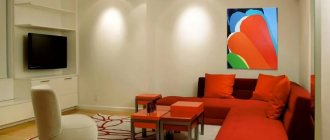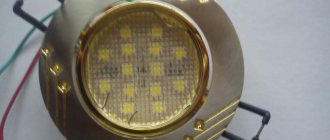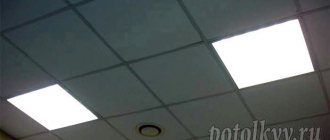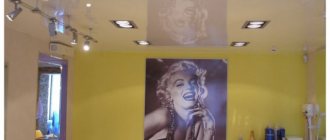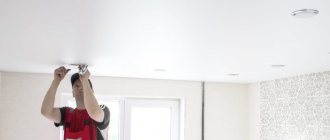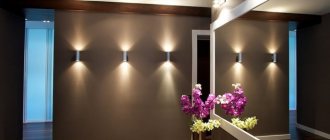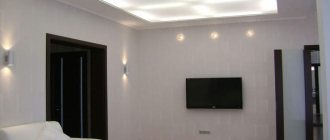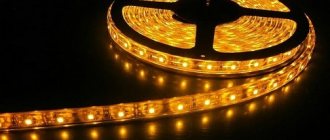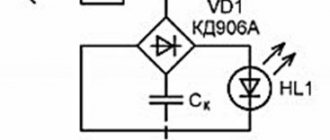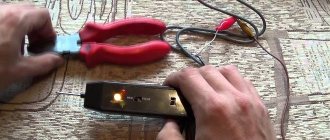A lonely hanging chandelier in the middle of the stream is becoming a thing of the past, and it has been replaced by a large number of devices that, without compromising the intensity of the light flux, consume less electricity and look more harmonious.
Stretch ceilings are the most common type of surface finish, which is easy to clean and creates a beautiful interior, but with this type of coating you need to take a responsible approach to choosing lamps.
Types of spotlights
Spotlights are usually divided into types according to the following set of characteristics: installation method, adjustment and functionality.
Installation method
Invoices
External or overhead spotlights are more often used on frameless bases:
- concrete ceiling;
- brick walls.
They are indispensable in cases where it is necessary to improve the interior without interfering with the dimensions of the room.
The design of the surface-mounted lamp consists of a mounting platform and a housing with a diffuser. Its features involve installing a mounting plate above a hole of smaller diameter than the housing itself. Otherwise, it will not be covered by the lampshade. It is important to connect the ground wire to the strip. The housing is fixed to the mounting platform using side screws after connecting the wires.
Built-in
Built-in or mortise models - the type installed on frame bases:
- plasterboard structures of all types;
- panel or slatted ceilings and walls;
- stretch ceilings;
- furniture partitions;
- wall niches.
Alternative options for using built-in points are in the floor, on stairs, in swimming pools, and bar counters.
The configuration of the luminaire is a body with built-in clamps for lamps and fastening elements. No additional reinforcement is required - the legs open behind the plane when installing the lampshade. The design involves mounting the housing inside a pre-prepared hole with wires connected to the exit point.
Hanging
The body of pendant spotlights is mounted at a distance from the mounting surface. The lamp is hung on a decorative power cable attached to the ceiling. No parts that can strengthen the structure are required. But it is recommended to supplement massive versions of lamps with mounting strips during installation - improvised ones made of timber or metal are also suitable.
Pendant lamps are suitable for installation on all types of bases and are often installed as an independent decorative element.
Adjustment type
Further division is based on the type of design, angle and intensity of the light flux.
- Rotating lamps. Used to create directional lighting with smooth angle adjustment. It is worth considering strengthening the fastening points during installation, since mobility implies accelerated wear of the material.
- Fixed models illuminate part of the room without adjusting the direction of the light flow.
- Swivel-and-slide devices are suitable for changing accents and lighting areas at the owner’s discretion.
- Cardan LEDs are notable for their advanced adjustment of the strength and direction of the flow. The housing houses several diode lamps simultaneously.
- Spots are lamps with a rotating mechanism that provide directional light. They are flexible and manually adjustable. Interesting solutions with different numbers of lampshades on a common fastener - six or more. They are arranged in the form of geometric shapes or chandeliers. Spots are available in built-in and surface-mounted versions.
- Downlight is used for spot lighting and emphasizing specific interior elements.
Functionality
The functional division of spotlights into types is determined by the basic configuration:
- possibility of remote control;
- extended lighting angle;
- adjustment in different planes;
- depth of installation (depending on the type of fastener);
- moisture and dust protection;
- dimming to adjust lighting.
The presented basic types of points are selected taking into account the characteristics of a particular room and interior elements.
What do you need to know?
From the very beginning, the buyer must understand what function the equipment will perform in a particular case.
Scope of application
Currently, spotlights can become a source of lighting for objects with different purposes:
- exhibition halls;
- billboards and signs;
- cafes, bars;
- restaurants;
- the shops.
Creating local illumination is the main function that devices perform under any conditions. They also organize the main lighting, but then more devices will be needed.
Installation is acceptable on any type of surface:
- Floors.
- Ceilings.
- Walls.
You can also often see spotlights inside furniture and interior items. They remain relevant in the case of public institutions.
Dimensions
LED spotlights and panels differ in dimensions:
- 30 by 30 cm;
- 29.5 by 119.5 cm;
- 17 by 60 cm.
LED products have a configuration in the shape of a circle or oval. square, triangle or polyhedron. In one housing it is allowed to combine two or three lamps at once to achieve a certain effect. 55-85 millimeters is the standard diameter. The level of suspended ceilings is maintained.
600 by 600 is another size of LED lamps that has become quite popular among buyers.
Mounting options
Based on installation methods, such products are also divided into several types:
- Hanging. They differ in the location of the housing at some distance from the ceiling structure.
- Embedded . One of the most popular options. Traditional installation technology is inside cuts on plasterboard surfaces. One of the main areas of application is illumination of cabinet furniture and various niches.
- Invoices. It is recommended to install if the ceiling surface has a solid base. For example, a concrete floor slab. What allows you to equip a special niche. Such models are suitable for implementing non-standard designer solutions.
Operating principle and design
The spotlight consists of three elements:
- a base that is attached to the surface;
- housings with clamps;
- connecting cable.
The vast majority of devices have a solid type housing.
Spotlights for incandescent lamps are structurally divided into two types:
- The open type is characterized by a U-shaped design.
- The closed type involves the use of a casing to protect the lamp from condensation; it is optimal for use in damp rooms.
Additional protection of the housing from high operating temperatures is not required. It is provided by the features of lamps built into the points. Their flasks are coated on the outside with mirror amalgam, which serves to protect the structure from overheating. The back surface of the bulb is matte, which promotes uniform distribution of light.
For correct operation of points with halogen lamps, a transformer is required. The principle is simple: the more lamps, the more powerful the transformer is needed. An induction or electronic option is suitable. During installation, the distance from the lamps to the device is taken into account - if it exceeds two meters, up to 100 W of power is lost due to resistance.
Characteristics
Spotlights have a number of features:
- Small angle of light dispersion (average 30 degrees). It must be taken into account that one point will not be able to provide the room with a sufficient amount of light, even in cases when we are talking about bathrooms.
- Cone-shaped stream of light. For uniform distribution, it is necessary to intersect habitats above chest level.
What's with the spotlights included?
The luminaire is supplied with a set of elements and accessories sufficient to connect to an active power circuit:
- Frame. Additionally, it comes with a lamp holder or diffuser.
- Mounting strip or mounting spacers.
- The terminal block is often solid, but sometimes the manufacturer includes only a couple of terminals in the kit.
The basic composition does not always include a lamp; more often it is purchased separately.
Lamps for spotlights
Spotlights are available in 3″, 4″, 5″ and 6″ fitting diameter variations. The values are in inches - according to the international standard. Can be used with different types of lamps:
- incandescent;
- compact fluorescent;
- halogen;
- LED.
The installation of lamps of different types is usually provided in the same housing. When purchasing, check whether the design is compatible with the selected type of lamp.
Incandescent lamps
They are most common in spotlights due to their low price and ease of replacement.
A number of disadvantages inherent in this type of lamps are slowly pushing them out of the market:
- “gluttony” in terms of electricity consumption;
- the fastener size is at least 7 cm, requiring a frame of appropriate depth.
Replacing incandescent lamps at points is the usual screwing into the lampshade.
Halogen
Interesting choice of power combination and long service life. A tungsten halogen device produces more light per watt than a standard incandescent bulb. Available in two voltage variations: linear at 220 or 110 W and low at 12 volts.
Halogen variations outperform incandescent lamps in these indicators:
- reduced energy consumption;
- durability;
- higher brightness;
- shallow fastening depth – 2–4 cm.
Disadvantages of halogen lamps:
- high heat;
- sensitivity to grease contamination;
- formation of high temperature zones.
Installation is carried out with gloves or use the cloth supplied.
Replacement:
- It is necessary to remove the decorative lampshade, if provided in the design.
- This will provide access to the locking ring - it can be removed by gently squeezing the two protruding tabs.
- After this, the light bulb itself is unscrewed.
LED spotlights
LED lighting technologies are known as a practical and durable alternative to incandescent lamps.
Their indicators contribute to this:
- record low energy consumption;
- no overheating, meaning full compatibility with all types of suspended ceilings;
- safety - suitable for use in children's rooms and bedrooms.
Luminescent
Optimal for simulating natural light. Their high price is offset by durability. The main disadvantage is that they are environmentally unsafe due to the presence of mercury. They are used with caution in residential areas.
Each type of lighting has a specific set of advantages and disadvantages. The most important factors when choosing a lamp:
- Light output is the ratio of the luminous flux power from the lamp to the same Watt indicator at the input.
- Preferred service life, difficulties in replacement and disposal.
- Maintaining luminous flux - this factor is important in order to have a certain minimum level of illumination.
- Need for auxiliary equipment.
For rational energy consumption, a dimmer (rheostat) is installed in addition to the lamps. This is a power switch that smoothly adjusts the brightness of the lighting.
Prices - what to save on?
Just a few years ago, this whole track lighting system cost some unreal money. That is why few people thought about using it in their home interior instead of the usual chandeliers or sconces.
Today the price breakdown looks something like this:
The plate shows the average cost of a single-phase busbar 3 m long and one lamp for it.
You can roughly estimate the prices for your apartment by choosing the appropriate quality and quantity.
Where can you save money here? Primarily in the bedroom and children's room.
We spend the smallest part of our active apartment life in the bedroom. Mostly we go there in the evening before going to bed.
What do 90% of people do? That's right, turn on the bedside lamp or sconce.
Therefore, if you have a modest budget, it is not at all necessary to install track lighting for this room. Mount it first in the living room or kitchen.
The same goes for the nursery. To avoid damaging your child’s vision, your child needs to create a uniform, high level of illumination.
Mistake #12
Therefore, the lighting of a children’s room does not necessarily need to be built on a fashionable, magnetic, ceiling-mounted track system that is difficult to integrate into a smart home.
Large modern LED panels do this best. They are much easier to install and cost much less.
What about bathrooms and toilets?
Mistake #13
If your designer has crammed track lights into the bathroom, then this is a serious reason to think about his competence.
The track system inherently cannot be reliably protected from moisture and dust. Installing this type of lighting in the bathroom is simply unsafe.
Advantages
Technical advantages are based on the following points:
- Possibility of partial or directional lighting to emphasize individual areas.
- Uniform illumination without shadowed corners.
- The service life is significantly longer than that of conventional chandeliers.
- Safe and economical supply of light, especially in variations with a voltage of 12 volts.
- Different types of light bulbs can be mounted into spotlights.
- Beauty and compactness. Thanks to their small size, they will look stylish and elegant in any room.
- Reduced energy consumption compared to conventional lighting devices, with high efficiency.
- Reliability. Resistance to vibrations and mechanical damage.
- High luminous flux utilization.
- There is no glare, noise or flickering during operation.
Colorful temperature
What color temperature should I choose? Models with temperatures from 2800K to 4000K are best suited for home use.
There is no need to chase bright, cold light, which is more suitable for lighting in offices.
Mistake #14
At the same time, be sure to check that the color temperature of all lamps located on the same busbar in the same room is the same.
Our eyes are very sensitive to such variations.
Flaws
Spot lighting has a number of disadvantages.
- Difficulty in organizing and designing a lighting system.
- The need to install or replace transformers significantly complicates installation and calculations. The requirement to maintain a distance from the device usually means partial reassembly of the frame and embroidering of the finished (sometimes covered with decor) plane. When replacing, the requirements are similar.
- The need to use more devices to create general lighting.
- Most types of spotlights require modifications to the ceiling or wall design. For built-in models, installing a frame is indispensable.
- If the spotlight overheats, it can damage the PVC stretch ceiling.
- Difficulty in maintaining a large number of lampshades.
How to choose spotlights
Standard spotlights have a regulated protection indicator. In the instructions or on the packaging it is designated by the abbreviation IP.
Abbreviation numeric values
Two numbers are placed next to the mark:
- The first number is protection against solid particles entering the structure. The range of values is from 0 to 5. Zero implies no protection. Values from 1 to 4 correspond to particle fraction sizes in descending order, ranging from 50 to 1 mm. Number 5 – protection against dust.
- The second number is the degree of moisture protection, standard values are from 0 to 8. The indicators correspond to the intensity of the water flow. Zero means no moisture protection, and 8 means that the device is protected from prolonged immersion in water.
Additional factors
- Choose equipment in the same style from one manufacturer.
- Check that the reflective and cooling element is complete.
- Low-power 12 W devices require the installation of a step-down transformer.
- The cable cross-section is selected according to special tables, based on the total power and number of lamps.
- Built-in ceiling models should be selected in advance in order to correctly calculate the height of the frame, taking into account the fastenings and overall dimensions of the transformer.
The rules for placing lighting fixtures determine their quantity and configuration when choosing.
Forms
Depending on the shape, recessed ceiling lights can be used in various interiors:
- LED devices in the shape of a semicircle are equipped with powerful diffusers, therefore they illuminate a large area and are often used on terraces and in spacious halls;
- for ordinary interiors, round products are used - the most standard and popular shape;
- oblong devices are used to illuminate individual objects, which is associated with a narrowly directed light flux (they can be seen in art galleries);
- cylindrical lamps are attached to a rotating stand, which allows you to change the direction of the glow (suitable for implementing various design solutions);
- rectangular or square devices are designed to create a unique design - non-standard ceiling lighting (for example, they can be arranged so that the luminous flux forms a rhombus).
Larger products are used in office rooms and general purpose areas.
Which ones are better
The simpler the design of the lamp, the easier it is to maintain. More often this applies to kitchen lighting fixtures, on which, in addition to dust, grease deposits accumulate over time.
- Rounded models are better suited for suspended ceilings - during their installation and subsequent maintenance, damage to the material by sharp corners is unlikely.
- Devices with incandescent lamps project bright, familiar light, but their mounting is not very compact. Ceiling and wall frames are mounted taking into account the size of the fasteners, as a result, precious centimeters of height or space of the room are “eaten up”.
- Lamps for halogen lamps can be built into the frame at a close distance from the surface - only 4 cm is lost. Additional advantages are reduced energy consumption, brightness and durability. Lamps with a ceramic socket and glass diffuser do not create problems with overheating.
The use of spotlights in conjunction with suspended ceilings implies a limitation on the power of the installed lamps. For halogen options, the threshold values are 35–40 W. For incandescent lamps this figure should not exceed 60 W.
Installation
There are certain requirements for the placement of light sources. The following rules will help you achieve the desired result:
- In the case of windows, you are allowed to conduct your own experiments. There are no strict standards for the placement of light sources relative to other elements. The main thing is a sufficient level of illumination.
- A symmetrical arrangement involves maintaining the same distance between components. Regarding the wall, this parameter is also preserved.
- One spotlight is enough for high-quality lighting of 1.5-2 square meters. But not every room needs bright light.
- The distance between the soffits and the seams of the ceilings should be at least 15 cm if stretched fabrics are used.
- A chandelier is placed strictly in the center of the ceiling.
- 20 cm is the minimum distance between the wall and the first row of spotlights.
Mounting options
Lighting devices are installed at the same time as the ceiling.
It is necessary to maintain a distance of 1-1.5 cm between the new and base coating. This will ensure ventilation, without which the devices will not be able to operate normally. The installation work maintains the general order; there are only some features characteristic of certain ceiling covering materials.
Calculation of the number of lamps
Lighting can be designed in a large number of ways. It is difficult to choose a location option that would suit absolutely everyone. Indeed, in each case, a large number of individual factors are taken into account - starting with the area of the room and ending with the location of the windows. It is worth deciding in advance whether the spotlights will be the source of the main or main illumination.
Calculating the quantity assumes the following scheme:
- We multiply the illumination rate with the area of the room. The result is the total power of the equipment used.
- Next, the power of each specific device is measured and the type is selected. The characteristics of the luminous flux are studied separately.
- Divide the total power by the power of the lamps. As a result, we see the number of devices for a particular room. All that remains is to choose the layout on the ceiling.
Lamp layout diagrams
Everything is individual here, general advice looks like this:
- If there is a chandelier, then the place where it is attached is the central part.
- A further composition is already being built around this component.
- In the absence of a chandelier, there are even more acceptable options than with one.
- Different zones are controlled by different switches.
How to use
The attractiveness of lamps in the interior and their service life depend on proper operation.
Recommendations for placement
- The lamps are mounted at a distance of 30–40 cm from each other and at least 20 cm from the corners of the room for uniform distribution of illumination.
- For suspended ceilings, energy-saving or LED lighting options are used, which heat up less.
- Dots along the perimeter of the walls will visually expand the space of the room. In this case, no ceiling lighting is required.
Care
- Once a year, you will need to clean the devices and check the integrity of the electrical wiring.
- Dry cleaning should be done using cotton cloths.
- Do not use solvents or abrasives for cleaning.
When replacing lamps, check the maximum permissible power, this will protect the backlight from overheating and fires.
Ceiling mount
What type of ceiling can this miracle be mounted on?
Mistake #6
For any.
Unless the lamp itself indicates that it is intended for certain types of ceilings. Check this at the selection stage.
In other cases, this is a truly universal product. Even tension, plasterboard, or bare concrete will do.
Some time ago, many construction teams involved in complex renovations refused to make suspended ceilings when they learned that the client would have track lighting.
Today, without any problems, you can get a special profile for this matter.
A built-in track is more suitable for gypsum board. This is when the tire is built inside and does not protrude beyond the plane of the ceiling.
For concrete planes, overhead mounting using conventional screws or dowels is used.
If you have very high ceilings, the entire structure can be assembled using hanging cables.
Mistake #7
However, do not forget about the restrictions on the weight and number of lamps.
When hanging, this is usually no more than 5 pieces of 5 kg per 1 meter.
Hanging models are most often used above kitchen islands, dining tables, and bar counters.
Don't want to spoil the ceiling? Place tracks directly on the wall!
Mistake #8
Just don’t bother with such a useless thing as linear modules built into the wall.
Such lighting does not provide any functionality, and even harms vision.
The main rule for placing any lamps is to do it so that the light from them does not shine directly into the eyes.
And with side illumination this is exactly what happens. You will not be able to sit normally in front of such a wall.
Even if you periodically pass by, you will receive an unpleasant “blow” to the eyes every time.
Malfunctions and repairs
Common malfunctions in most cases come down to incorrect operation of installed accessories.
Some time after switching on the device stops working
A possible reason is overheating of the transformer and subsequent tripping of the protective shutdown. In this case, it will be necessary to replace the transformer with a more powerful version or move it to an open space to improve heat dissipation. Alternatively, replace the current transformer with several units of lower power.
Lamps flickering when lights are off
This drawback is inherent in LED or energy-saving lamps and manifests itself when incompatible with an illuminated switch. Solving the problem will require replacing the fittings or the type of lamps used.
Frequent burnout
There are a number of reasons why this can happen: from frequent power surges to imported lamps designed to operate on a 220 V network. To solve the problem, install protection devices or replace the lamps with energy-saving or low-voltage ones.
Doesn't turn on or goes out immediately
A common reason for this phenomenon is a simple overload of the transformer when too many devices are connected at the same time. It will be necessary to replace the device or increase the number of transformers.
The lamp melted and cracked
It is possible that the power of the installed lamp exceeds the permissible limit. You can check the indicators on the boxes if they have been preserved. You will need to install lamps of the correct power.
Manufacturers of spotlights
The selection includes representatives of different price categories:
- Ambrella. It has been producing its own line since 2012. Ambrella light products are distinguished by their original design, and the bonus is a level of service comparable to the European one. Budget models.
- ARTE LAMP. The Italian company ARTE LAMP has been supplying interior lighting products since 2001 and is represented in more than 20 countries around the world. Average price level.
- Donolux. A Russian company with 15 years of experience, producing economical lamp models. Materials are supplied by global manufacturers. The product quality is at a decent level. The pricing policy is not designed for the middle class.
- EGLO. An Austrian company specializing in the creation of lighting systems, an assortment of 3,000 items to suit every taste and budget. Budget models and mid-price options are available.
- Elektrostandard. Another representative of Russia, on the market since 1998. Products are traditionally of high quality. Price level is in the standard range.
- Lightstar. A European company offering interesting design solutions in lighting. Present in Russia since 2001. The pricing policy is moderate.
- LUSSOLE. Lussol is an inexpensive Italian product presented in an elegant and extraordinary format.
- Massive. Belgian appliances with a laconic design. The company offers series for each room at average prices. Noteworthy are the options adapted to children's interiors.
- Novotech. A reliable Hungarian company, present on the market for 20 years. Offers special lighting series for bathrooms. Budget pricing policy.
After you decide on the functionality and model, you will need to calculate the number of lamps and make a diagram of their location in the room.
Common installation options: around the perimeter, at a distance from corners and walls of 20 cm, in a checkerboard pattern or in the shape of geometric shapes. Advertising from sponsors: // // //
